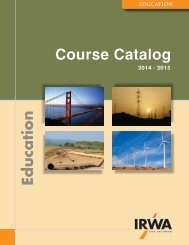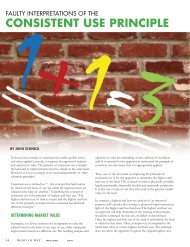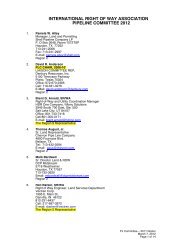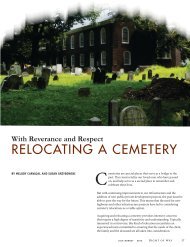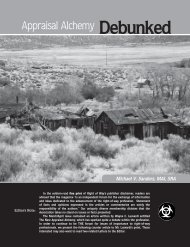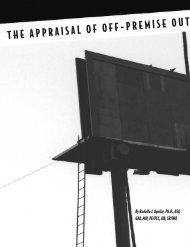the highest value <strong>of</strong> the land as <strong>of</strong> the date <strong>of</strong> valuation. A potential(future) highest and best use is not the standard used unless that use isreasonably probable. Highest and best use concerns the use <strong>of</strong> land andnot the owners or buyers <strong>of</strong> property. Business value is outside <strong>of</strong> thescope <strong>of</strong> highest and best use.WHOLE PROPERTY — Sometimes referred to as the entirety, thelarger parcel, or the parent tract. Some appraisers distinguish betweenthe three. <strong>The</strong> term whole property asused in this report means a propertyunder a single ownership, physicallycontiguous and with one highest and bestuse throughout. Cases <strong>of</strong> commonownership, physical contiguity and morethan one highest and best use indicatemore than one economic unit and thus,more than one whole property. <strong>The</strong>market value <strong>of</strong> the whole property placesthe ceiling on just compensation. That isto say, the market value <strong>of</strong> a part takencannot exceed the market value <strong>of</strong> thewhole property, although the taking canresult in damages in excess <strong>of</strong> the marketvalue <strong>of</strong> the partial acquisition.PARTIAL ACQUISITION — Alsovariously referred to as the part taken,take, or partial take. A fee taking involvesall <strong>of</strong> the rights <strong>of</strong> ownership; however, aneasement involves a partial taking <strong>of</strong>rights, and, in many cases, the interesttaking involves but a portion <strong>of</strong> the totalproperty. Different kinds <strong>of</strong> partialtakings include 1) the fee taking <strong>of</strong> a part<strong>of</strong> the total property; 2) an easementtaking affecting the total property; and 3)an easement taking <strong>of</strong> part <strong>of</strong> the totalproperty.An easement acquisition is always apartial acquisition. Even if the proposedeasement physically covers the entiresubject whole property, the underlyingfee estate is not acquired. <strong>The</strong> underlyingfee owner still has a beneficial interest inthe property. A partial acquisition caninvolve physical property or legal rights(such as access rights), or both. <strong>The</strong>appraisal <strong>of</strong> easements requiresidentification <strong>of</strong> the type <strong>of</strong> easement andthe physical parts <strong>of</strong> the total property affected.REMAINDER PROPERTY — <strong>The</strong> remainder property includes thoseportions <strong>of</strong> the total property not taken plus the property rightsremaining to the owners <strong>of</strong> the easement area itself. For example, apipeline easement across a farm will leave the landowner with land areasnot within the easement, plus the right to use the surface area <strong>of</strong> theeasement area after construction for crops. As a result <strong>of</strong> some easementacquisitions, the remainder property may have a different highest andbest use than that <strong>of</strong> the original whole property.RIGHT OF WAY — As used in this article, right <strong>of</strong> way will refer tothe area within the boundaries <strong>of</strong> the easement in which the utility,pipeline, or telecommunication facility is installed. For example, thepipeline right <strong>of</strong> way width may be 50 feet. A right <strong>of</strong> way may be acrossa particular property. A right <strong>of</strong> way can also be a route across manydifferent properties, as in the case <strong>of</strong> a pipeline or a fiber optic line. A rightFEATUREIn the valuation<strong>of</strong> easementsfor publicacquisition, themeasure <strong>of</strong> valueis always the lossin the value <strong>of</strong>the burdenedproperty, notthe value <strong>of</strong>the easementto the taker.<strong>of</strong> way can also include fee simple property. A right <strong>of</strong> way should not beconfused with an easement. In most cases, a right <strong>of</strong> way will crossmultiple properties and will consist <strong>of</strong> several easements. An easement isunique to one property. Both terms, as they relate to the subject property,should be discussed within the appraisal report. Another commonmistake is to confuse a right <strong>of</strong> way with a corridor. A corridor is alwaysa right <strong>of</strong> way, but a right <strong>of</strong> way is not necessarily a corridor. Corridorsare discussed later in this article.EASEMENT — An easement is aspecifically defined interest (estate) inproperty and is owned by someone otherthan the owner <strong>of</strong> the underlying feesimple interest. It is a dominant estateand the underlying fee is a servient estate.<strong>The</strong> easement document specificallydelineates what property rights areinvolved and should be included in theappraisal report. No two easements areexactly alike. Each easement is associatedwith a particular property and is uniquefrom other easements on that propertyand to easements situated on otherproperties. <strong>Easements</strong> are not a type <strong>of</strong>highest and best use. An individualeasement is not a right <strong>of</strong> way system orcorridor.USER IMPROVEMENTS — <strong>The</strong>seare the physical improvements orstructures placed within the right <strong>of</strong> waysuch as a pipeline, electric transmissionline, telecommunications cable, etc. Thisfacility may be situated on a singleproperty or may extend across manyseparate properties.<strong>The</strong> user improvements in easementareas are owned and operated bysomeone other than the underlying feeowner. Any value, cost, pr<strong>of</strong>it or revenuefrom operation <strong>of</strong> the user improvementsgoes to its owner and not to theunderlying fee owner. Revenue fromoperating the infrastructure is a businessventure separate from the value <strong>of</strong> theland burdened by an easement.PROJECT INFLUENCE — In thepartial taking <strong>of</strong> a right <strong>of</strong> way for a givenproject, the purpose <strong>of</strong> the project andthe proposed user improvements can impact the value <strong>of</strong> the remainderproperty. It can lower the value <strong>of</strong> the remainder (damage), raise the value(benefit), or have no impact on the remainder value. <strong>The</strong> projectinfluence rule says that any impact on value affects only the remainderand should not be considered when appraising the whole property value.Valuation <strong>of</strong> the whole property and the partial acquisition is estimatedbefore considering the project influence. <strong>The</strong> remainder property isvalued after considering the impact <strong>of</strong> the project.CORRIDOR — Corridors should not be confused with easements. Acorridor is a property use rather than an estate. Stated another way, acorridor is a type <strong>of</strong> highest and best use, while an easement is generallyan estate or interest in land. A highest and best use as a corridor is marketdriven as opposed to an arbitrary delineation, and the reasonableprobability <strong>of</strong> users is necessary.right <strong>of</strong> way ✦ NOVEMBER/DECEMBER 2001 41
H.C. PECK & ASSOCIATESINC.A FULL SERVICE NATIONALRIGHT-OF-WAY COMPANYHELEN C. PECK, PresidentMarket Center Building, 1624 Market St., Suite 205Mailing Address: P.O. Box 480306, Denver, CO 80248-0306(303) 623-6112 • Fax (303) 623-6301www.hcpeck.comFEATURE<strong>Right</strong>s <strong>of</strong> way across an individual property are typically in the form <strong>of</strong> aneasement; however, the user may own in fee some portions in a given length <strong>of</strong>right <strong>of</strong> way (across multiple properties). Only when the land across a given length<strong>of</strong> right <strong>of</strong> way is in the absolute control <strong>of</strong> a one entity, may the length be definedas a right <strong>of</strong> way corridor (and this assumes that other tests are met as well). Insome circumstances, the individual existing rights <strong>of</strong> way easements are not in thecontrol <strong>of</strong> an individual entity, and changes and sale <strong>of</strong> the corridor for additionalusers is not possible without the additional consent <strong>of</strong> the individual owners <strong>of</strong> theunderlying fee simple estate. For example, if a railroad is situated within a physicalcorridor but owns only the right to use as a railroad, and the individual fee ownerscontrol other uses (such as laying a pipeline or fiber optic line), then that right <strong>of</strong>way cannot be defined as a marketable corridor in an economic sense.A corridor has a number <strong>of</strong> characteristics. Any corridor connects importantdemand points while an easement extends to the boundaries <strong>of</strong> only one property.A corridor avoids congestion to the extent that it bypasses many properties,allowing a user to avoid buying right <strong>of</strong> way from many different owners. That isto say a corridor provides a distance advantage due to transport across manyownerships. <strong>The</strong> corridor owners provide services such as engineering,maintenance and surveillance. Corridors are typically marketed as an entity.Owners <strong>of</strong> corridors rent or sell right <strong>of</strong> way within the corridor to users whowish to place their user improvements within it. However, the physical corridor isnot classified as a right <strong>of</strong> way corridor unless the rights to use can be obtainedfrom a single entity without the necessity <strong>of</strong> getting also the same rights from allthe basic fee owners <strong>of</strong> the land. <strong>The</strong>re is considerable literature on the subject <strong>of</strong>corridor valuation and some has been included in the bibliography.VALUATION CONSIDERATIONS<strong>The</strong> proper valuation methodology for easements is the “before and after” rule.A variation <strong>of</strong> this rule is the “take plus damages” rule. Generally, case law andappraisal literature support this methodology. Strictly speaking, the appraiser doesnot appraise an easement but rather measures the impact <strong>of</strong> the easement on theburdened property. <strong>The</strong> measure and impact (value) <strong>of</strong> an easement is the loss invalue to the remainder property after imposition <strong>of</strong> theeasement. This diminution is comprised <strong>of</strong> both theeasement acquisition and damage (if any) to theremainder. Different jurisdictions have different lawsgoverning the valuation <strong>of</strong> partial takings and theappraiser should be careful to use that methodologyapplicable in the subject property’s jurisdiction.In the valuation <strong>of</strong> easements for public acquisition,the measure <strong>of</strong> value is always the loss in the value <strong>of</strong>the burdened property, not the value <strong>of</strong> the easementto the taker. <strong>Appraisal</strong> methodology is focused on themarket value <strong>of</strong> the property and should beconsistently applied. <strong>The</strong> valuation methodologyused should not vary regardless <strong>of</strong> the nature <strong>of</strong> theproposed project, who the buyers will be, or who theowner is. Additionally, it should not vary whether agovernmental agency is involved or if it takes place inthe private sector.VALUATION OF THE WHOLE PROPERTY — <strong>The</strong>whole property is appraised before any consideration<strong>of</strong> the proposed project. <strong>The</strong> whole property is notburdened by the proposed project in the beforescenario and the market data collected for the wholeproperty value estimate should not reflect any projectinfluence.VALUATION OF THE PARTIAL ACQUISITION —<strong>The</strong> proposed acquisition area to be burdened by theeasement is appraised in the before situation and willhave the same per unit value as that <strong>of</strong> the wholeproperty. All easement acquisitions are partial42 NOVEMBER/DECEMBER 2001 ✦ right <strong>of</strong> way






